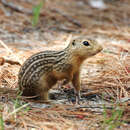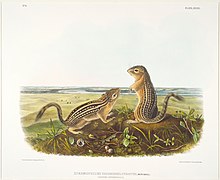en
names in breadcrumbs


Previously also known as Citellus tridecemlineatus (Long 1994).
Thirteen-lined ground squirrels have excellent senses of vision, touch, and smell. They use alarm calls and other sounds, as well as using special scented secretions, to communicate with other squirrels. They rub glands around their mouth on objects to leave scent marks. They also greet one another by touching noses and lips.
Perception Channels: tactile ; chemical
This animal has been expanding its range from the prairie states northward and eastward as land is cleared.
US Federal List: no special status
CITES: no special status
State of Michigan List: no special status
IUCN Red List of Threatened Species: least concern
Consumes agricultural crops like corn, wheat, oats and sunflowers although the damage is limited to the harvest season, not during winter storage.
Negative Impacts: crop pest
Thirteen-lined ground squirrels impact plant communities by eating seeds and foliage. They act as important prey bases for small predators, such as weasels, raptors, and snakes, and help to recycle soil nutrients through their burrowing activities. They also play host to many ectoparasites including fleas, lice, mites, ticks and to endoparasites.
Spermophilus tridecemlineatus is omnivorous. Spermophilus means "seed lover," and this squirrel eats the seeds of weed plants as well as available crop species like corn and wheat. It will eat the leaves of grass and clover and hoardes plant material underground, transporting it in cheek pouches. Animal matter consumed includes insects, occasional small vertebrates, bird eggs and carrion. (Kurta 1995, Palmer 1995)
Animal Foods: eggs; carrion ; insects; terrestrial non-insect arthropods
Plant Foods: leaves; roots and tubers; seeds, grains, and nuts; fruit
Foraging Behavior: stores or caches food
Primary Diet: omnivore
Spermophilus tridecemlineatus is found in central North America. Originally confined to the prairie, it has extended its range northward and eastward over the past two centuries as land has been cleared. Currently S. tridecemlineatus can be found as far east as Ohio and as far west as Montana and Arizona. It reaches its northern limit in central Alberta and Saskatchewan and is found as far south as the Texas coast.
Biogeographic Regions: nearctic (Native )
Spermophilus tridecemlineatus prefers open areas with short grass and well-drained sandy or loamy soils for burrows. It avoids wooded areas. Mowed lawns, golf courses, cemetaries, well-grazed pastures, parks and roadsides are common habitats for it now that it is no longer limited to prairie regions. (Jones 1988, Kurta 1995)
Habitat Regions: temperate
Up to 90% of newborns die from predation before hibernation begins. Once they have reached adulthood Thirteen-lined ground squirrels probably live for only a few years.
Average lifespan
Status: captivity: 7.9 years.
total body length: 225 to 300 mm tail length: 75 to 109 mm
Spermophilus tridecemlineatus is a small slender ground squirrel with alternate longitudinal stripes of dark brown and tan, extending from the nape to the base of the tail. The dark brown stripes are broader than the tan lines and have tan rectangular spots along the midline. The "thirteen lines" consist of either (1) seven broad dark brown stripes alternating with six thin tan bands or (2) seven narrow yellow stripes alternating with six broader dark brown stripes. The ears are short, and the tail is thin and sparingly bushy. This squirrel often sits erect with head pointed up.
The skull of Spermophilus tridecemlineatus is sciurognathous and sciuromorphous, meaning that the lower jaw is v-shaped and that there is a large zygomatic plate anterior to the orbit where the lateral masseter arises. The infraorbital foramen is small and shifted forward. A postorbital process is present. The dental formula is 1/1, 0/0, 2/1, 3/3. Like all rodents, S. tridecemlineatus lacks canines, has evergrowing incisors with enamel only on the front and sides, and has a large diastema separating incisors and cheek teeth.
(Kurta 1995, Jones 1988, Palmer 1995, Lawlor 1979)
Range mass: 110.0 to 140.0 g.
Range length: 170.0 to 310.0 mm.
Average length: 250.0 mm.
Sexual Dimorphism: sexes alike
Other Physical Features: endothermic ; bilateral symmetry
Average basal metabolic rate: 0.983 W.
Thirteen-lined ground squirrels give alarm calls when they sense the presence of a predator, then all surrounding squirrels escape into their burrows. Main predators include snakes and hawks, such as red-tailed hawks and Cooper's hawks.
Known Predators:
Spermophilus tridecemlineatus is promiscuous. Females mate within five days of spring emergence from hibernation. Copulation stimulates ovulation within 1 to 2 days. Gestation lasts 28 days. Between 7 and 14 young are born, with an average of 8 to 9. They are blind, hairless and toothless and weigh 4 gm. The young gain 1.3 gm/day, open their eyes at day 13, leave the burrow for the first time at 28 to 35 days, and are full grown in 90 days. At six weeks, offspring dig their own burrow, usually within 100 m of where they were born. Females have one annual litter. Up to 90% of newborns die from predation before hibernation begins. (Kurta 1995, Jones 1988, Palmer 1995)
Breeding interval: Each year females only give birth to one litter.
Breeding season: Upon emergence from hibernation, April or early May
Range number of offspring: 6.0 to 13.0.
Average number of offspring: 8.5.
Average gestation period: 28.0 days.
Average weaning age: 6.0 weeks.
Average age at sexual or reproductive maturity (female): 1.0 years.
Average age at sexual or reproductive maturity (male): 1.0 years.
Key Reproductive Features: iteroparous ; seasonal breeding ; gonochoric/gonochoristic/dioecious (sexes separate); sexual ; fertilization ; viviparous
Average birth mass: 3.24 g.
Average gestation period: 28 days.
Average number of offspring: 7.
Average age at sexual or reproductive maturity (male)
Sex: male: 225 days.
Average age at sexual or reproductive maturity (female)
Sex: female: 354 days.
The young are born blind, hairless, and toothless and weigh 4 g. They are nursed and cared for in the burrow by their mother. The young gain 1.3 g each day, open their eyes at day 13, leave the burrow for the first time at 28 to 35 days, and are full grown in 90 days. At six weeks old, members of the litter begin digging their own burrows, usually within 100 m of where they were born.
Parental Investment: altricial
The thirteen-lined ground squirrel (Ictidomys tridecemlineatus), also known as the striped gopher, leopard ground squirrel, and squinney (formerly known as the leopard-spermophile in the age of Audubon), is a ground squirrel that is widely distributed over grasslands and prairies of North America.
It is brownish, with 13 alternating brown and whitish longitudinal lines (sometimes partially broken into spots) on its back and sides, creating rows of whitish spots within dark lines.[2]
This species has usually been placed in the genus Spermophilus with about 40 other species. As this large genus is paraphyletic to prairie dogs, marmots, and antelope squirrels, Kristofer Helgen and colleagues have split it into eight genera, placing the thirteen-lined ground squirrel in Ictidomys with two other species.[3]
The thirteen-lined ground squirrel is strictly diurnal and is especially active on warm days. A solitary or only somewhat colonial hibernator, it often occurs in aggregations in suitable habitats.
In late summer, it puts on a heavy layer of fat and stores some food in its burrow. It enters its nest in October (some adults retire much earlier), rolls into a stiff ball, and decreases its respiration from between 100 and 200 breaths per minute to one breath about every five minutes. It emerges in March or early April.
The burrow may be 15 to 20 feet (4.6 to 6.1 metres) long, with several side passages. Most of the burrow is within one to two feet (about half a meter) of the surface, with only the hibernation nest in a special deeper section. Shorter burrows are dug as hiding places. This ground squirrel's home range is two to three acres (0.8 to 1.2 ha).

Its primary diet includes grass and weed seeds, caterpillars, grasshoppers, and crickets, but it may also eat mice and shrews; it will viciously attack and consume cicadas if able to catch them. This squirrel sometimes damages gardens by digging burrows and eating vegetables, but also devours weed seeds and harmful insects.
It is well known for standing upright to survey its domain, diving down into its burrow when it senses danger, then sometimes poking out its nose and giving a bird-like trill. The "trill" is an alarm call that is most often used by females to warn nearby relatives.[4] It has a maximum running speed of 8 mph (13 km/h) and reverses direction if chased.
The thirteen-lined ground squirrels have solitary habits, shown by agonistic behaviors to squirrels invading their own areas, which they've evolved, requiring less energy and the risk of getting injuired. Tail-flicking is also evolved from their solitary habits, which allows them not to violate other squirrel individuals' space.[5]
Thirteen-lined ground squirrels can survive in hibernation for over six months without food or water and special physiological adaptations allow them to do so.[6] During torpor, these squirrels maintain hydration by redistributing and storing osmolytes like sodium, glucose, and blood urea nitrogen in different body compartments (to be identified).[6] When they enter a transient active-like state, small periods of arousal where these squirrels return to an active-like state temporarily, osmolarity and antidiuretic hormone levels rise while thirst remains suppressed. [6] Thirteen-lined ground squirrels also suppress the cell cycle and control the expression of cell cycle regulators in the liver during hibernation to conserve energy.[7] Moreover, they are able to maintain their muscle contractile performance during hibernation. Although scientists determined that there is a reduction in the squirrels' muscle mass during torpor, this does not significantly change the muscles' contractile properties.[8] During hibernation, thirteen-lined ground squirrels prioritize skeletal muscle tissue for maintenance and potential regrowth.[8] They also increase their muscle antioxidant capacity during torpor to protect tissue from oxidative damage associated with the restoration of blood flow during the transition period from torpor to arousal.[9] During hibernation, they mobilize fatty acids for fuel instead of glycogen, which is kept constant during hibernation.[10] During their active-like state, they are able to resume their cell cycle.[7]
The thirteen-lined ground squirrel (Ictidomys tridecemlineatus), also known as the striped gopher, leopard ground squirrel, and squinney (formerly known as the leopard-spermophile in the age of Audubon), is a ground squirrel that is widely distributed over grasslands and prairies of North America.